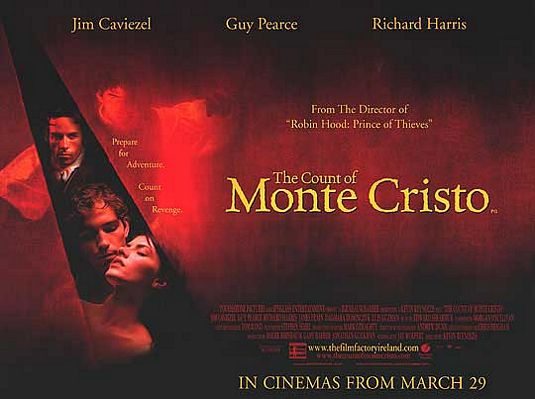
The Count of Monte Cristo (2002)
- by admin
- Posted on 25 August, 2024
“The Count of Monte Cristo,” directed by Kevin Reynolds and released in 2002, is a cinematic adaptation of Alexandre Dumas’s classic novel of the same name. The film stars Jim Caviezel as Edmond Dantès and Guy Pearce as Fernand Mondego, and it explores themes of revenge, justice, and redemption. This essay delves into the film’s narrative, character development, thematic elements, and its impact on audiences.
“The Count of Monte Cristo” follows the story of Edmond Dantès, a young and promising sailor who is falsely accused of treason by his jealous rivals. At the height of his success, Dantès is betrayed by those he considered friends and is imprisoned in the Château d’If, a notorious fortress. The film portrays Dantès’s transformation from an innocent man into a vengeful and calculating figure as he escapes from prison and takes on the identity of the wealthy and enigmatic Count of Monte Cristo.
The plot unfolds as Dantès meticulously orchestrates his revenge against those who wronged him, including his former friend Fernand Mondego, who married Dantès’s fiancée Mercedes (Dagmara Dominczyk) in his absence. As Dantès exacts his vengeance, he grapples with questions of justice and morality, ultimately seeking redemption and understanding the true meaning of forgiveness.

Jim Caviezel delivers a compelling performance as Edmond Dantès, capturing the character’s emotional depth and complexity. Caviezel’s portrayal of Dantès effectively conveys the character’s transformation from a naive and hopeful young man into a sophisticated and driven avenger. The emotional weight of Dantès’s journey is apparent in Caviezel’s nuanced performance, which balances the character’s quest for vengeance with his underlying vulnerability.
Guy Pearce’s portrayal of Fernand Mondego provides a formidable antagonist. Pearce captures Mondego’s ambition and ruthlessness, presenting a character who is driven by jealousy and a desire for power. Mondego’s complex motivations and moral ambiguity make him a compelling foil to Dantès, and Pearce’s performance enhances the film’s dramatic tension.
Supporting performances by Dagmara Dominczyk as Mercedes and Richard Harris as Abbe Faria further enrich the film. Dominczyk’s portrayal of Mercedes conveys her emotional conflict and enduring love, while Harris’s role as the wise and supportive Abbe Faria adds depth to Dantès’s character development. Faria’s mentorship and guidance play a crucial role in Dantès’s transformation and his ultimate quest for redemption.

“The Count of Monte Cristo” explores several central themes, including revenge, justice, and redemption. The theme of revenge is at the heart of the film’s narrative, as Dantès seeks to right the wrongs committed against him. The film examines the consequences of vengeance, exploring how it can consume and transform a person. Dantès’s quest for revenge, while initially driven by a sense of justice, ultimately leads him to confront the moral implications of his actions.
Justice is another significant theme, with the film questioning the nature of justice and the limits of personal retribution. Dantès’s actions raise ethical questions about the right way to seek justice and whether his pursuit of vengeance ultimately serves the greater good. The film challenges viewers to consider the complexities of justice and the impact of personal actions on others.
Redemption is a key theme that emerges as Dantès reflects on his journey and the consequences of his actions. The film portrays Dantès’s struggle to reconcile his desire for revenge with his quest for personal redemption. His interactions with other characters and his ultimate decisions highlight the theme of forgiveness and the search for inner peace.

The film’s visual and cinematic elements contribute to its storytelling and thematic depth. The historical setting, costumes, and production design create an immersive environment that transports viewers to 19th-century France. The film’s use of cinematography and visual effects enhances the dramatic tension and grandeur of the story, particularly in scenes depicting Dantès’s transformation and his elaborate plans for revenge.
The score, composed by Klaus Badelt, complements the film’s emotional and dramatic moments, adding an additional layer of intensity and atmosphere. The music underscores the film’s themes and heightens the impact of key scenes, further immersing viewers in the narrative.
“The Count of Monte Cristo” received generally positive reviews for its engaging adaptation of Dumas’s classic novel. Critics praised the film for its strong performances, particularly by Jim Caviezel and Guy Pearce, as well as its faithful adaptation of the source material. The film’s exploration of complex themes and its dramatic narrative resonated with audiences, contributing to its success and enduring appeal.
While some critics noted that the film’s pacing and adaptation of certain elements from the novel could be improved, it remains a notable entry in the genre of historical adventure and drama. The film’s ability to capture the essence of Dumas’s novel and its exploration of timeless themes have cemented its place as a compelling adaptation of a literary classic.
“The Count of Monte Cristo” (2002) is a richly engaging film that successfully adapts Alexandre Dumas’s classic novel into a dramatic and thought-provoking cinematic experience. Through its exploration of revenge, justice, and redemption, the film offers a powerful narrative that challenges viewers to consider the complexities of morality and personal retribution. The strong performances, immersive visual elements, and thematic depth contribute to the film’s enduring appeal and make it a noteworthy adaptation of a timeless literary work.
“The Count of Monte Cristo,” directed by Kevin Reynolds and released in 2002, is a cinematic adaptation of Alexandre Dumas’s classic novel of the same name. The film stars Jim Caviezel as Edmond Dantès and Guy Pearce as Fernand Mondego, and it explores themes of revenge, justice, and redemption. This essay delves into the film’s…